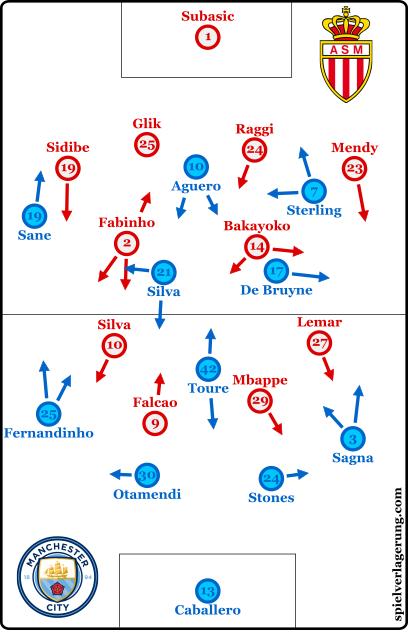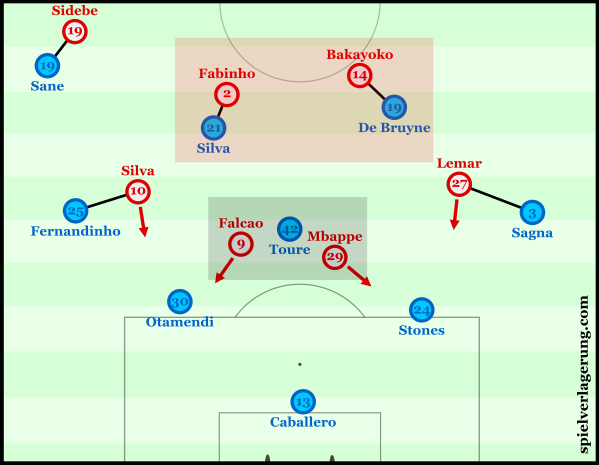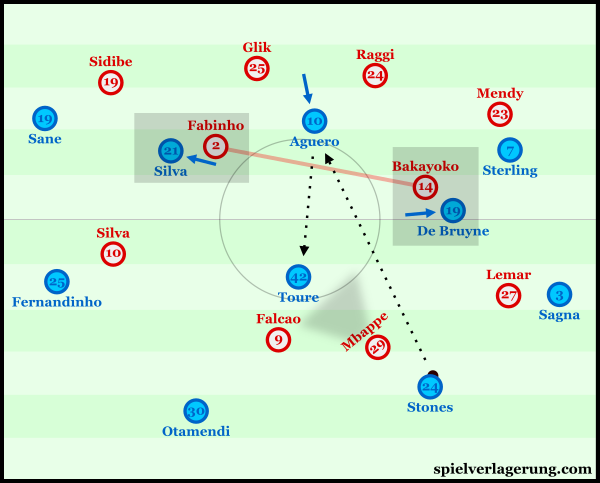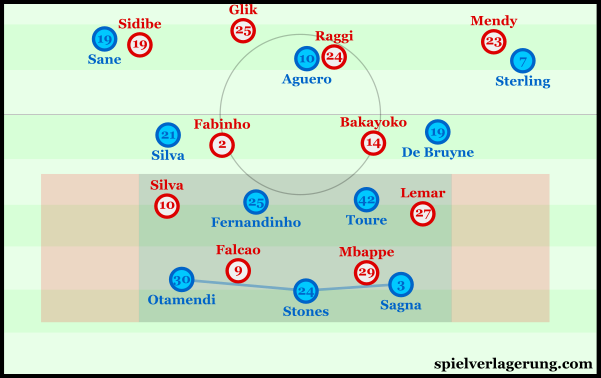City exploit man-orientated defending to edge exciting game with Monaco
Leonardo Jardim brought his potent Monaco attack to the Etihad last night, ensuing what was one of the most entertaining clashes of the season so far.
The intensity of football was extremely high, as Monaco’s fast-paced attack and pressing came up against Manchester City’s alluring possession game. The result was a chaotic and unpredictable match at a high tempo, resulting in eight goals and ten yellow cards.
 Monaco approached the game in their usual 4-2-2-2 shape, with Kylian Mbappé starting over Valère Germain as Falcao’s attacking partner. City used the 4-3-3 shape which has become common after their short spell with a 4-1-2-1-2. In possession, it was more specifically a 2-3-2-3 with Fernandinho and Sagna playing fairly deep as full-backs.
Monaco approached the game in their usual 4-2-2-2 shape, with Kylian Mbappé starting over Valère Germain as Falcao’s attacking partner. City used the 4-3-3 shape which has become common after their short spell with a 4-1-2-1-2. In possession, it was more specifically a 2-3-2-3 with Fernandinho and Sagna playing fairly deep as full-backs.
Monaco’s pressing
As many sides have recently done, Monaco looked to pressure their host’s build-up, in order to disrupt their passage into midfield. Their efforts were in a man-oriented fashion, with Falcao and Mbappé covering Touré, but then moving out to engage the centre-backs or even the goalkeeper at times. On either side of them, B. Silva and Lemar closely followed Fernandinho and Sagna respectively while both sixes were responsible for D. Silva and De Bruyne.
Fabinho’s following of D. Silva was sometimes an exception. The Spanish midfielder increasingly dropped during build-up in reaction to Monaco’s pressing, to the extent that sometimes he was on the edge of City’s own box. During such moments, Fabinho was reluctant to follow yet, because of Monaco’s heavy presence in these zones, D. Silva was unable to be a consistent influence.
In some cases, the shape was lopsided with B. Silva joining the front two and Lemar dropping into the midfield, forming a narrow 4-3-3 shape. In both shapes, they would look to isolate Stones and Sagna down the left side of the pitch. Falcao or Mbappé would close him down horizontally, often with Touré in their cover shadow while Lemar maintained a position from which he could attack the right-back. In a deeper position, the full-back kept a tight coverage of Sterling and De Bruyne remained under the watch of Bakayoko.
Through either approach, Monaco benefited from a high level of defensive access in challenging the ball-carrier and restricting his immediate options. It suited their high-intensity approach to defending in City’s third and allowed them to pressure their opposition into more direct progressions. Jardim’s side were able to force a handful of turnovers within the final third which not only stunted City’s possession at times, but gave them dangerous attacking opportunities, too.
Monaco’s defensive issues
While Monaco’s man-orientation gave them a beneficial level of defensive access in their pressing, it played a significant part in their ultimate downfall. With both sixes occupied by Manchester City’s attacking midfielders, Guardiola’s side were given the licence to manipulate their opponent’s structure. They did so by dragging Bakayoko and Fabinho into wide positions, through inside-out movements of Silva and De Bruyne.
The effect was a lack of central occupation from the away side, with large distances not only between the two midfielders, but between them and their centre-backs too. City then sought to exploit these situations with Sergio Agüero dropping deep from Raggi and Glik and receiving vertical passes between the lines. The striker performed his role at a high level, displaying great balance and strength under the pressure of Raggi, and excellent technique to control difficult passes and accurately bring a team-mate into play.
In some cases, Agüero would immediately lay the ball off to Touré, who was now free behind Monaco’s first line of pressing. Dropping deeper, the striker had a limited field of view through facing his own goal, so by laying it off to the Ivorian, City were in a better position to continue the attack quickly. Furthermore, due Monaco’s pressing, Touré would become a free-man in these situations, meaning he could carry the ball forward and force a Monaco six to leave his assignment, leaving one of Silva or De Bruyne open.
With Agüero dropping deeper, Andrea Raggi would often follow in pursuit, which would leave temporary gaps in the defensive line. This was a trigger for Sané and Sterling to showcase their speed by making runs into gaps behind the defensive line. Thus, whoever Agüero laid the ball off to would have an opportunity to play a fast lobbed ball over the top of the Monaco defence.
This movement pattern also helped City to retain ball control after their direct build-ups in reaction to Monaco’s pressure. Alone in front of the opponents’ defensive line, Agüero was in a strong position to intercept any loose balls and carry the ball towards goal.
City’s change of shape
Despite a few promising moments, Guardiola decided to adjust his side’s shape in possession. Where previously they had been a 2-3-2-3 (W-W), at around 20 minutes they moved into a three-man line in build-up, and thus was instead a 3-2-2-3 (M-W). Sagna began to play deeper in build-up while the Brazilian stand-in left-back moved into a central position that he is more familiar with. The front of the shape remained untouched with Silva and De Bruyne coming up behind Sané, Agüero and Sterling.
There are multiple explanations for this adaption, with one of the most likely being the need for greater protection against Monaco’s pressing. With an additional player in the defensive line, the away side were unable to apply their pressure as well in their man-to-man fashion. City’s first line could better cover the width of the pitch, which forced Falcao and Mbappé to cover more ground in their pressing thus weakening their access and ability to cause a turnover.
If Monaco did manage to win the ball back, there was an extra defender in their path to the goal, too. Considering the pace of their forwards, transitions are a dangerous moment for Jardim’s side, and after already being caught out once or twice, Guardiola preferred a more cautious approach to build-up.
Extending from this, City’s build-up benefited not only from a precautionary point of view, but helped them to develop possession more cleanly and quickly, too. The additional centre-back made switching the play easier, as Monaco now found it more difficult to break the chain through cover shadows.
In some scenes, the spacing of the left half of the structure was miscommunicated and not ideal. Otamendi sometimes failed to react to Fernandinho’s inside movement, and didn’t balance the shape by moving closer to the touchline himself. This often created a narrow shape with Fernandinho on the same vertical line as Otamendi, as opposed to being diagonally connected.
Sané was often staying high in City’s structure, which meant that they didn’t have any presence leftwards of the left half-space. Although these situations gave Silva room to move outwards into, it sometimes resulted in the hosts not using the full width of the pitch. In turn, Monaco would have an easier time of pressing their opponents, without the presence of a wider player stretching their front four.
Another issue was the narrowness of the back three, which sometimes failed to cover the pitch from half-space to half-space. Doing so shortened the length of the passes between them, which made for a more horizontal ball circulation. Not only this, but their inadequate width-coverage reduced the quality of passing angles for the half-backs – especially on diagonal lanes back into the centre.
It was a welcome invitation to enforce a higher press from Monaco, and City brought upon themselves a couple of unstable moments. The narrow ‘3-2’ constricted their build-up and, with less space to cover in their pressing, Mbappé and Falcao were able to press effectively despite the underload.
The change of shape wasn’t set-in-stone, however, and the home side showed some variability within their structure. In some cases, Yaya Touré dropped between the centre-backs with Sagna joining Fernandinho in the six space. When playing through the left half-space, Fernandinho would actually stay close to the touchline, probably to stretch the press and provide David Silva with more space to manoeuvre in. Once the play had progressed, he could tuck in to provide Sané with more space to isolate his man, or stay wide if the winger wanted to cut inside.
And that is exactly what he did for the first goal, as City’s three-man defence and gave Stones the time to play a lofted pass towards Silva, who had moved towards the touchline in space vacated by the now-inside Fernandinho. The ball moved onto Sané who squeezed through three defenders, and after being tackled was threaded through by Silva, before squaring the ball (an extremely common tactic of City) to Sterling for the easy finish.
Monaco’s intensity lowers
Whether in reaction to City’s change, or part of a more time-based strategy, Monaco’s press was dropped slightly after 30 minutes. The two strikers, instead of hunting down Stones and Otamendi would cover passes into the host’s now-double pivot. In doing so, they invited their opposition towards wider areas where they could attempt to trap them.
However, City were still able to progress fairly consistently, through their more vertical approach to Monaco’s defence. Otamendi was still able to reach Agüero when the striker dropped between Monaco’s stretched sixes, and could then lay the ball off to one of Silva and De Bruyne. Silva’s pressing-resistance was also useful in these moments, in addition to his outwards movements which gave his team a better presence closer to the touchline.
Chaotic last 30
City levelled the game with a typical counter-attack – a tactic which their possession game (and the presence of Guardiola) means they’re underrated for by many. The pace and individual quality of the front three, as well as De Bruyne behind them makes them a threat against many teams. It’s concealment within their more deliberate passing game just makes it more of a danger.
But Monaco went back ahead with a counter of their own just three minutes later. Lemar received the ball deep and was able to pitch a lofted ball behind Sagna, which allowed Falcao to isolate and then beat Stones, who couldn’t match the striker’s speed of turn inside. Exquisite finish to follow.
Guardiola then introduced Zabaleta in place of Fernandinho, and the Argentinian moved to right-back while Sagna swapped sides to the left. Yaya Touré became more active on the right side of the build-up, while Sagna would come inside as Fernandinho had. When Touré dropped into the first line, D. Silva would join the second line of players to help ensure an adequate presence in the midfield.
The change also saw Zabaleta offer more width on the right side of the pitch, and could offer as a way out of pressure and means of advancing the possession while Monaco were compact. It was through him how City managed to gain a succession of corners which ended in Agüero’s second equaliser of the game.
At 3-3, Monaco resumed their pressing game which we had seen towards the start of the clash. Yet with fatigue firmly set in, mistakes were much more common and City were able to find direct passages into attack. What the pressure did do, however, was increase the speed of the game with the hosts enjoying a faster route to goal.
Conclusion
Although clear features could be seen in the game, the chaotic nature brought about a lot of random elements too, with football already being an unpredictable sport. City’s issues in their game highlighted a team still in development, yet one which still out-scored one of the best attacks in Europe. Their defensive issues have improved since their poor period around mid-January, but individual problems were once again on show.
From the other side, Monaco’s unusually-weak defensive performance let themselves down significantly. Their reactivity and lack of compactness in midfield played right into the hands of Guardiola’s side, who must be credited for their execution of exploiting such weaknesses.






2 Kommentare Alle anzeigen
kpl tactics February 27, 2017 um 6:58 pm
Why did Monaco opt to be man-oriented in midfield? In my opinion isn’t it more important for the defensive player/play to be about sticking to your zone. Afterall this is what compaction is.
Unless it is the space between the lines being covered against movement then I don’t see need to follow Silva and De Bruyne.
Benji February 24, 2017 um 10:31 pm
Who actually wrote this? Great stuff!